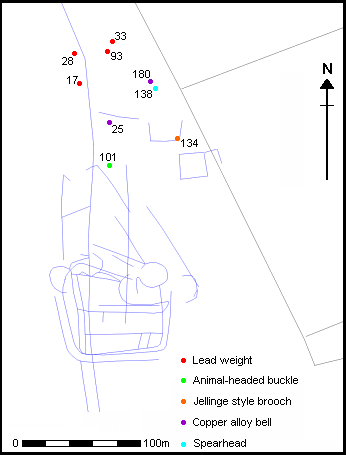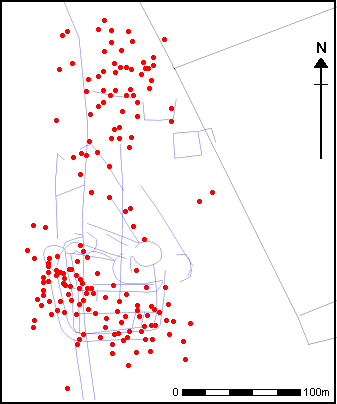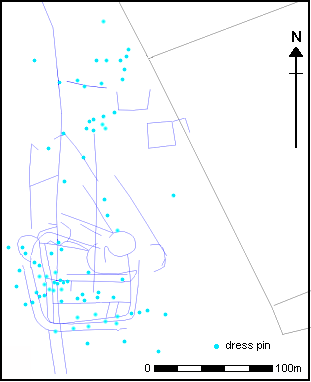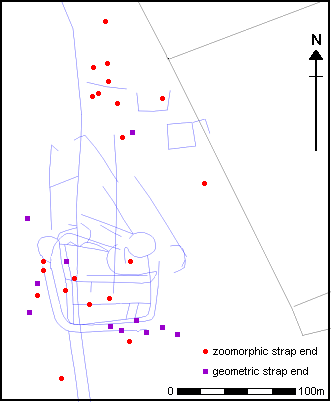
The majority of the metal detected finds from Cottam B have already been published in the Yorkshire Archaeological Journal (Haldenby 1990, 1992, 1994) but the opportunity has been taken here to present a series of distribution maps, and a full catalogue and concordance list of these artefacts in the Finds Database.
The site at Cottam B was first discovered in 1987. Over sixty pieces of eighth and ninth century date were found over the following two autumn seasons, during approximately 200 man-hours of searching by five metal detector enthusiasts (Haldenby 1990, 51), at a recovery rate of one object per three hours of detecting. The importance of the site was appreciated at an early stage and the non-ferrous metal finds were systematically plotted by allocating each find a unique number and pacing out the find location in relation to the present field boundary and gate to the east of the site (Haldenby pers comm). Although this was a fairly crude measure it is believed to have yielded reasonably accurate finds spots which have subsequently been entered into the project GIS, along with the unique identifying number. No attempt was ever made to recover non-metallic artefacts, other than unusual finds, although the presence of pottery and bone has been acknowledged by the metal detector enthusiasts and substantiated by the results of field-walking (Didsbury 1990). The majority of the metal finds recovered during 1987-89 were published in Yorkshire Archaeological Journal 62, although the location of the site was withheld to prevent indiscriminate looting by other metal detectorists. Metal detecting continued during 1990, although the rate of recovery had by now decreased to approximately one artefact per six hours of detecting (Haldenby 1992, 25); the new finds were published in a second paper in the Yorkshire Archaeological Journal 64 (Haldenby 1992). Finally, a third batch of finds was published in Yorkshire Archaeological Journal 66 (Haldenby 1994) although new discoveries continue to be made following ploughing, albeit at a decreasing rate. The site is now regarded to be virtually worked-out and it is safe to reveal its location as the recovery rate would be unattractive to casual metal detectorists unfamiliar with the area (Haldenby pers comm). For the purposes of this catalogue unlocated finds have been allocated numbers from 300 onwards.
The detected finds from Cottam B now include some 68 dress pins, 34 strap-ends, 7 rings, 4 brooches (including one in Jellinge-style), 5 lead weights, over 35 iron knife blades, and 2 Norse bells. There are also some 19 Roman coins, 3 eighth-century sceattas, and 22 ninth-century stycas. All the finds will ultimately be deposited with Hull Museums and Art Galleries.
Query the Cottam Finds Database
All the finds recovered have been found in ploughsoil, close to the surface. The site has been regularly ploughed to a depth of c.0.15-0.2m (6-9 inches) for cereal cultivation but, on at least one occasion, it has also been 'subsoil ploughed' for the planting of potatoes, resulting in disturbance of material to a depth of c.0.4m (15 inches) (Robert Bannister pers comm). It has been noted that this led to the recovery of additional metalwork from the ploughsoil (David Haldenby pers comm). In some areas broken chalk is visible on the surface, and the site may have suffered from topsoil erosion from raised areas; in other places it appears that topsoil survives to a depth of at least 0.3m (12 inches). Several of the metal items are quite corroded, having suffered from agricultural disturbance, whereas much appears to have only been ploughed up in recent years and is still in a good state of preservation. The finds are spread over a wide area and several appear to have been broken in antiquity.
Figure 26: Distribution of tenth-century metal objects

By plotting the distribution of the metal finds (see figure 27) it became apparent that there are two main concentrations. These clusters are believed to be real as the surrounding fields were also intensively detected and did not yield these densities of artefacts. The southern concentration coincides with the crop mark enclosure but there is also a general spread of metal artefacts to the north of this. Objects datable to the eighth and ninth century are predominantly but not exclusively found in the southern group, whilst those of the later ninth and tenth century (see figure 26) are predominantly but not exclusively in the northern group.
Figure 27: Distribution of metal detector finds superimposed on cropmarks and modern field boundaries

Figure 28: Distribution of coins discovered by metal detector and excavation

Most of the stycas (see figure 28) were also found in the southern group; this would also be consistent with a settlement shift to the north as coin usage on rural sites is believed to decrease in the tenth century (Blackburn 1993). The lead weights were originally published as spindle whorls but should now be seen as weights, of a type recovered from Dublin (Patrick Wallace pers comm). Their distribution is focussed entirely upon the north enclosure, also reflecting the reversion to a barter economy. Some artefact types, such as the dress pins (see figure 29), appear to be chronologically undifferentiated, each type occurring in both the south and north enclosure areas. When other categories of find are grouped by type interesting differences in distribution begin to emerge, reinforcing the value of using locational information for plough zone finds in order to develop artefact typologies.
Figure 29: Distribution of dress pins discovered by metal detector and excavation

The strap ends (see figure 30) fall into two broad categories. These groups can be described as zoomorphic - those employing animal motifs (including Trewhiddle style strap ends), and geometric - those not employing animal motifs. These broad types have been further sub-divided into 21 groups by Haldenby (1997, 1998a, 1998b) on the basis of a study of some 400 strap ends recovered by detectorists. Where known, Haldenby's classification is also tabulated in the database notes (G1-G21). Where the artefacts are badly worn no classification has been offered. It is apparent from the distribution (see figure 30) that, with the exception of a single outlier, the strap ends with geometric ornament are confined to the area of the south enclosure, whilst those decorated with zoomorphic ornament are found in both concentrations. The zoomorphic strap ends with Trewhiddle style ornament are also found across both areas. This would suggest that geometric types went out of fashion at the end of the ninth century, and were not used in the tenth century. This is at odds with Haldenby's view that the geometric Arc and Step type (his Group 19) is late in the sequence, but it is proposed that the evidence from horizontal stratigraphy from the excavations at Cottam B should lead to a revision of that typology, based as it is on the assumption that the generally lower level of technical accomplishment seen on the Arc and Step type is indicative of a debased and later production date. On the other hand, the presence of both examples of the Animal Mask type (Haldenby Group 13) in the northern group might lend some support to his other proposal that these are an Anglo-Scandinavian type produced in York (Haldenby 1998a, 40). Finally, four of the Cottam strap ends - each in the southern group (003, 043, 068, and 079) - have been recognised as members of a distinctive type which have traces of inlaid silver wire ornament, generally set in rectangular panels. These four are seen as outliers of a distribution which is focussed on East Anglia (Thomas 1996). Their coincidence with the south enclosure at Cottam supports the ninth century dating of the type.
Figure 30: Distribution of strap ends discovered by metal detector and excavation

© Internet Archaeology
URL: http://intarch.ac.uk/journal/issue10/richards/md.html
Last updated: Tue May 15 2001